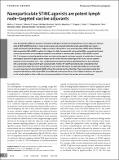| dc.contributor.author | Crespo, Monica P. | |
| dc.contributor.author | Abraham, Wuhbet | |
| dc.contributor.author | Chen, Stephanie H. | |
| dc.contributor.author | Mueller, Stefanie | |
| dc.contributor.author | Moynihan, Kelly Dare | |
| dc.contributor.author | Melo, Mariane Bandeira | |
| dc.contributor.author | Irvine, Darrell J | |
| dc.contributor.author | Szeto, Gregory | |
| dc.contributor.author | Hanson, Melissa Catherine | |
| dc.date.accessioned | 2015-10-23T18:06:21Z | |
| dc.date.available | 2015-10-23T18:06:21Z | |
| dc.date.issued | 2015-05 | |
| dc.date.submitted | 2014-11 | |
| dc.identifier.issn | 0021-9738 | |
| dc.identifier.issn | 1558-8238 | |
| dc.identifier.uri | http://hdl.handle.net/1721.1/99440 | |
| dc.description.abstract | Cyclic dinucleotides (CDNs) are agonists of stimulator of IFN genes (STING) and have potential as vaccine adjuvants. However, cyclic di-GMP (cdGMP) injected s.c. shows minimal uptake into lymphatics/draining lymph nodes (dLNs) and instead is rapidly distributed to the bloodstream, leading to systemic inflammation. Here, we encapsulated cdGMP within PEGylated lipid nanoparticles (NP-cdGMP) to redirect this adjuvant to dLNs. Compared with unformulated CDNs, encapsulation blocked systemic dissemination and markedly enhanced dLN accumulation in murine models. Delivery of NP-cdGMP increased CD8[superscript +] T cell responses primed by peptide vaccines and enhanced therapeutic antitumor immunity. A combination of a poorly immunogenic liposomal HIV gp41 peptide antigen and NP-cdGMP robustly induced type I IFN in dLNs, induced a greater expansion of vaccine-specific CD4[superscript +] T cells, and greatly increased germinal center B cell differentiation in dLNs compared with a combination of liposomal HIV gp41 and soluble CDN. Further, NP-cdGMP promoted durable antibody titers that were substantially higher than those promoted by the well-studied TLR agonist monophosphoryl lipid A and comparable to a much larger dose of unformulated cdGMP, without the systemic toxicity of the latter. These results demonstrate that nanoparticulate delivery safely targets CDNs to the dLNs and enhances the efficacy of this adjuvant. Moreover, this approach can be broadly applied to other small-molecule immunomodulators of interest for vaccines and immunotherapy. | en_US |
| dc.description.sponsorship | Bill & Melinda Gates Foundation | en_US |
| dc.description.sponsorship | Ragon Institute of MGH, MIT and Harvard | en_US |
| dc.description.sponsorship | National Institutes of Health (U.S.) (AI091693) | en_US |
| dc.description.sponsorship | National Institutes of Health (U.S.) (AI095109) | en_US |
| dc.description.sponsorship | National Cancer Institute (U.S.) (Koch Institute Support (Core) Grant P30-CA14051) | en_US |
| dc.description.sponsorship | National Institutes of Health (U.S.) (Ruth L. Kirschstein National Research Service Award 1F32CA180586) | en_US |
| dc.description.sponsorship | Hertz Foundation (Graduate Fellowship) | en_US |
| dc.description.sponsorship | National Science Foundation (U.S.). Graduate Research Fellowship | en_US |
| dc.language.iso | en_US | |
| dc.publisher | American Society for Clinical Investigation | en_US |
| dc.relation.isversionof | http://dx.doi.org/10.1172/jci79915 | en_US |
| dc.rights | Article is made available in accordance with the publisher's policy and may be subject to US copyright law. Please refer to the publisher's site for terms of use. | en_US |
| dc.source | PMC | en_US |
| dc.title | Nanoparticulate STING agonists are potent lymph node–targeted vaccine adjuvants | en_US |
| dc.type | Article | en_US |
| dc.identifier.citation | Hanson, Melissa C., Monica P. Crespo, Wuhbet Abraham, Kelly D. Moynihan, Gregory L. Szeto, Stephanie H. Chen, Mariane B. Melo, Stefanie Mueller, and Darrell J. Irvine. “Nanoparticulate STING Agonists Are Potent Lymph Node–targeted Vaccine Adjuvants.” J. Clin. Invest. 125, no. 6 (May 4, 2015): 2532–2546. © 2015 American Society for Clinical Investigation | en_US |
| dc.contributor.department | Massachusetts Institute of Technology. Department of Biological Engineering | en_US |
| dc.contributor.department | Massachusetts Institute of Technology. Department of Materials Science and Engineering | en_US |
| dc.contributor.department | Ragon Institute of MGH, MIT and Harvard | en_US |
| dc.contributor.department | Koch Institute for Integrative Cancer Research at MIT | en_US |
| dc.contributor.mitauthor | Hanson, Melissa C. | en_US |
| dc.contributor.mitauthor | Crespo, Monica P. | en_US |
| dc.contributor.mitauthor | Abraham, Wuhbet | en_US |
| dc.contributor.mitauthor | Moynihan, Kelly Dare | en_US |
| dc.contributor.mitauthor | Szeto, Gregory Lee | en_US |
| dc.contributor.mitauthor | Chen, Stephanie H. | en_US |
| dc.contributor.mitauthor | Melo, Mariane Bandeira | en_US |
| dc.contributor.mitauthor | Mueller, Stefanie | en_US |
| dc.contributor.mitauthor | Irvine, Darrell J. | en_US |
| dc.relation.journal | Journal of Clinical Investigation | en_US |
| dc.eprint.version | Final published version | en_US |
| dc.type.uri | http://purl.org/eprint/type/JournalArticle | en_US |
| eprint.status | http://purl.org/eprint/status/PeerReviewed | en_US |
| dspace.orderedauthors | Hanson, Melissa C.; Crespo, Monica P.; Abraham, Wuhbet; Moynihan, Kelly D.; Szeto, Gregory L.; Chen, Stephanie H.; Melo, Mariane B.; Mueller, Stefanie; Irvine, Darrell J. | en_US |
| dc.identifier.orcid | https://orcid.org/0000-0001-7604-1333 | |
| mit.license | PUBLISHER_POLICY | en_US |
| mit.metadata.status | Complete | |
